Technology
How AI in Self Driving Cars is Changing the Automobile Industry – Everything to Know
Published
2 years agoon
By
Admin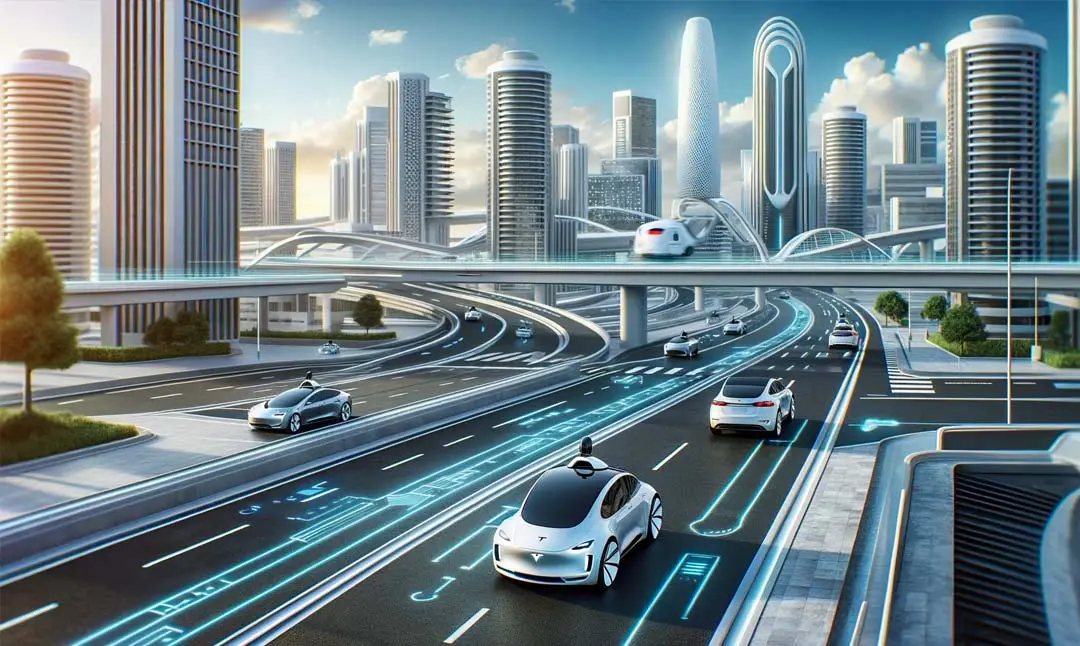
Artificial intelligence (AI) has transformed many industries, but transportation is one of the most impactful. AI-driven self-driving cars are fundamentally changing our approach to travel, enhancing safety and improving convenience.
This transformative technology not only automates driving but also introduces new ways to manage traffic and vehicle interactions, which could lead to fewer road accidents and a smoother traffic flow.
In this article, we will explore how AI in self-driving cars is changing the automobile industry, from its key features and benefits to the challenges it faces and its future potential.
What is AI in Self-Driving Cars?
Artificial Intelligence in self-driving cars is the technology that enables these vehicles to drive themselves without a human driver. This advanced technology uses a combination of sophisticated algorithms, various sensors, and powerful data processing systems to perceive the environment around the vehicle accurately.
Moreover, these AI systems allow the car to make smart decisions, such as when to speed up, slow down, or avoid obstacles.
Although the idea of self-driving cars has existed for many years, but after improvements in AI technology have only recently made this concept a reality. Thanks to these advancements, self-driving cars are now being tested on roads. They could soon become a common sight, offering a new way of traveling that promises increased safety and convenience.
How AI Works in Self-Driving Cars
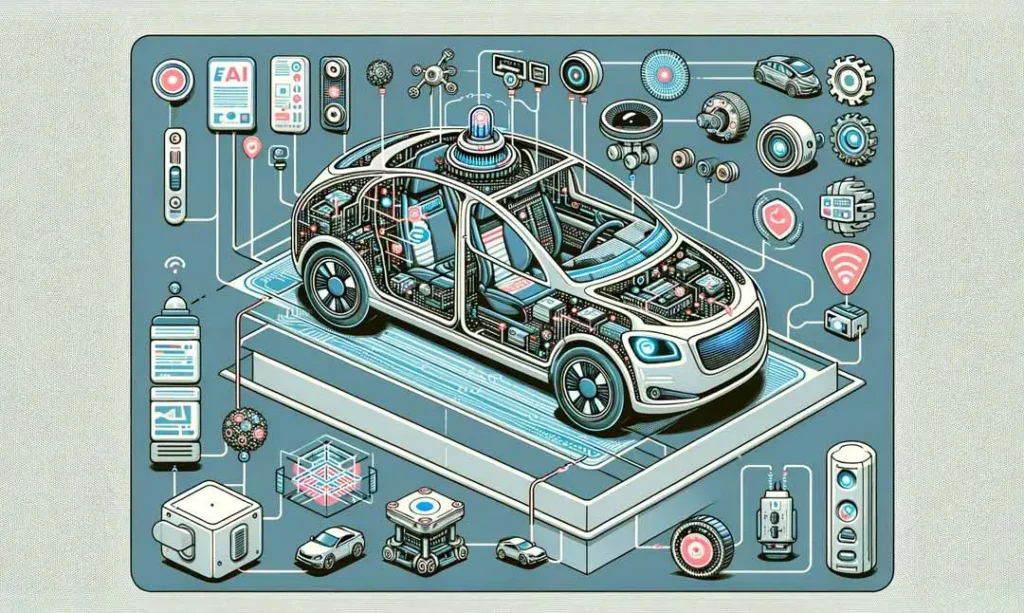
AI in self-driving cars works through a mixture of sensors and data analysis. These cars come with cameras, LIDAR (Light Detection and Ranging), radar, and ultrasonic sensors to gather information about their surroundings. The AI then processes this data to build a detailed map of the environment, identify objects, predict their movements, and make real-time decisions about navigation and safety.
Sensors and Data Collection
Sensors act as the eyes and ears of self-driving cars:
- Cameras: Capture visual information, like road signs, traffic lights, and other vehicles.
- LIDAR: Uses laser pulses to create accurate 3D maps of the area around the car.
- Radar: Detects objects and measures their speed and distance from the car.
- Ultrasonic Sensors: These are used for short-range detection of obstacles, such as when parking.
Machine Learning and Decision-Making
Machine learning is vital for AI in self-driving cars. Here’s how it works:
- Training on Data: AI systems are trained using large amounts of data to recognize patterns. This includes images of pedestrians, cyclists, and different types of vehicles.
- Recognizing Patterns: The AI learns to differentiate between various objects and predict their movements. For example, it can tell if an object is a pedestrian or a cyclist and predict where they might go next.
- Making Decisions: Based on the data, the AI makes real-time decisions. It can decide when to stop, slow down, or change lanes to avoid obstacles or hazards.
This combination of sensors and machine learning allows self-driving cars to understand complex situations and make safe driving decisions.
Features of AI in Self-Driving Cars
AI enables several advanced features in self-driving cars, making them capable of handling various driving tasks.
1. Autonomous Navigation
AI allows self-driving cars to navigate without human input. The vehicle can plan routes, follow traffic rules, and adapt to changing road conditions. This autonomous navigation is powered by real-time data processing and decision-making algorithms.
2. Real-Time Traffic Analysis
Self-driving cars use AI to analyze traffic conditions in real-time. This helps them avoid congestion, choose the fastest routes, and improve overall travel efficiency. By communicating with other vehicles and traffic management systems, they can make informed decisions to optimize traffic flow.
3. Pedestrian and Obstacle Detection
AI systems in self-driving cars are designed to detect and respond to pedestrians and obstacles. Using sensors and computer vision, these vehicles can identify objects on the road, predict their movement, and take necessary actions to avoid collisions.
4. Advanced Driver-Assistance Systems
Many self-driving cars are equipped with ADAS, which includes features like adaptive cruise control, lane-keeping assistance, and automatic emergency braking. These systems enhance safety by providing real-time support to drivers and taking over control when needed.
Benefits of AI in Self-Driving Cars
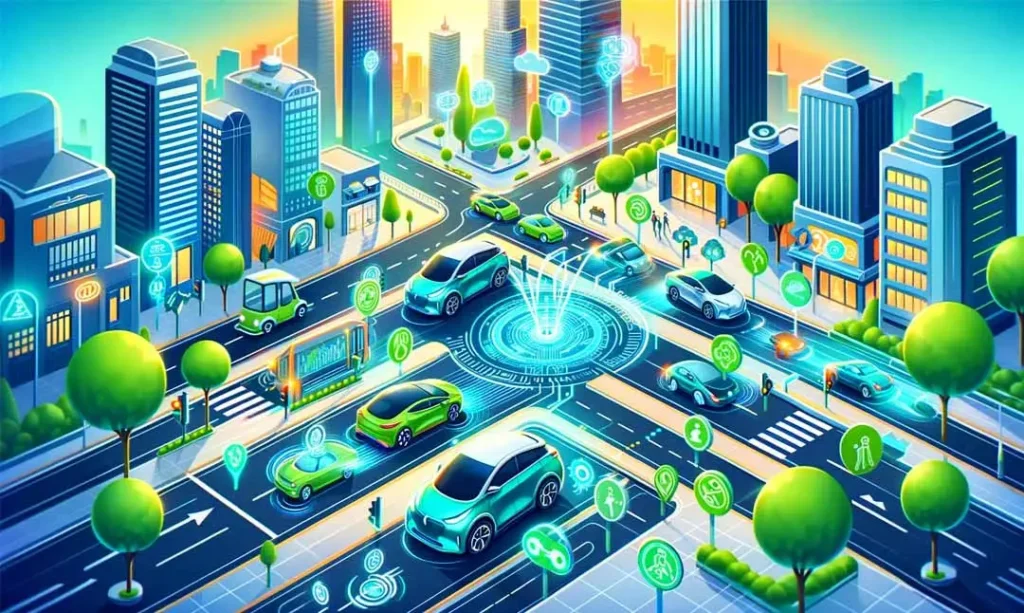
Integrating AI in self-driving cars offers numerous benefits. Some of the top benefits of AI in self-driving cars include:
-
Increased Safety
One of the most significant advantages of AI in self-driving cars is increased safety. According to a study by the National Highway Traffic Safety Administration (NHTSA), human mistake is responsible for approximately 93% of road accidents. AI can reduce these errors by making more accurate and timely decisions, potentially saving thousands of lives each year.
-
Reduced Traffic Congestion
AI helps reduce traffic congestion by optimizing route planning and improving traffic flow. Self-driving cars and traffic management systems can communicate with each other to share real-time information, avoid congested areas, and distribute traffic more evenly across the road network.
-
Enhanced Fuel Efficiency
AI can improve fuel efficiency by optimizing driving behaviors. For example, AI can manage acceleration and braking patterns to minimize fuel consumption and reduce emissions. This not only benefits the environment but also lowers operating costs for vehicle owners.
-
Convenience for Drivers and Passengers
Self-driving cars offer a new level of convenience for drivers and passengers. With AI handling the driving tasks, individuals can relax, work, or enjoy entertainment during their commute. This is particularly beneficial for those with long commutes or mobility issues.
Challenges and Limitations

Despite the good benefits, AI in self-driving cars faces several challenges and limitations that need to be managed for adoption.
1. Technical and Ethical Challenges
Developing reliable AI systems for self-driving cars is technically complex. Ensuring these systems can handle all possible driving scenarios, including rare and unexpected events, is a significant challenge. Additionally, ethical considerations, such as decision-making in unavoidable accident scenarios, need to be carefully addressed.
2. Legal and Regulatory Issues
The deployment of self-driving cars requires a supportive legal and regulatory framework. Laws and regulations need to be updated to address issues related to liability, insurance, and data privacy. Governments and regulatory bodies must work closely with industry stakeholders to create a conducive environment for autonomous vehicles.
3. Public Perception and Trust
Gaining public trust is crucial for the success of self-driving cars. Many people are still skeptical about the safety and reliability of autonomous vehicles. Education and awareness campaigns, along with transparent communication about the technology and its benefits, can help build public confidence.
Impact on the Automobile Industry
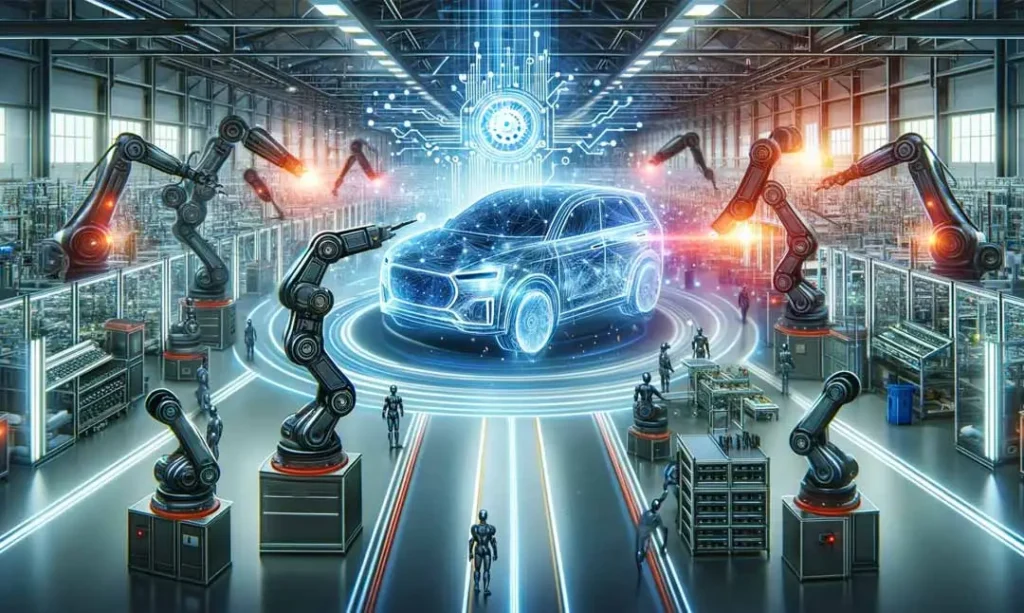
AI in self-driving cars is reshaping the automobile industry in several ways, from manufacturing and design to new business models and services.
-
Changes in Car Manufacturing and Design
The design and manufacturing of cars are evolving to accommodate AI and autonomous technologies. Vehicles are being built with advanced sensors, computing power, and connectivity features to support self-driving capabilities. This shift is driving innovation in automotive engineering and design.
-
New Business Models and Services
The rise of self-driving cars is leading to new business models and services. Ride-sharing companies like Uber and Lyft are investing in autonomous vehicle technology to offer more efficient and cost-effective services. Car subscription services, where users can access a fleet of autonomous vehicles on demand, are also emerging as a popular alternative to traditional car ownership.
-
Impact on Traditional Car Ownership
Self-driving cars are changing the concept of car ownership. With the convenience of on-demand autonomous vehicles, many people may choose not to own a car. This shift could reduce the number of personally-owned vehicles on the road, leading to decreased traffic congestion and more efficient use of transportation resources.
Future of AI in Self-Driving Cars
The future of AI in self-driving cars looks fortunate, with continuous advancements in technology and increasing market adoption.
Expected Advancements in AI
AI technology is expected to continue advancing, leading to more sophisticated and capable self-driving systems. Improvements in machine learning algorithms, sensor technology, and computing power will enable self-driving cars to handle even more complex driving scenarios with greater accuracy and reliability.
Fully Autonomous Vehicles
While many self-driving cars currently operate with some level of human oversight, the goal is to achieve full autonomy. Fully autonomous vehicles, capable of driving without human intervention, are expected to become a reality in the coming years. This will further enhance the safety, efficiency, and convenience of transportation.
Integration with Smart Cities
AI in self-driving cars will be integrated with smart city infrastructure, creating a seamless and efficient transportation network. Self-driving cars will communicate with traffic signals, road sensors, and other vehicles to optimize traffic flow, reduce congestion, and improve overall transportation efficiency.
AI in Self-Driving Cars Examples
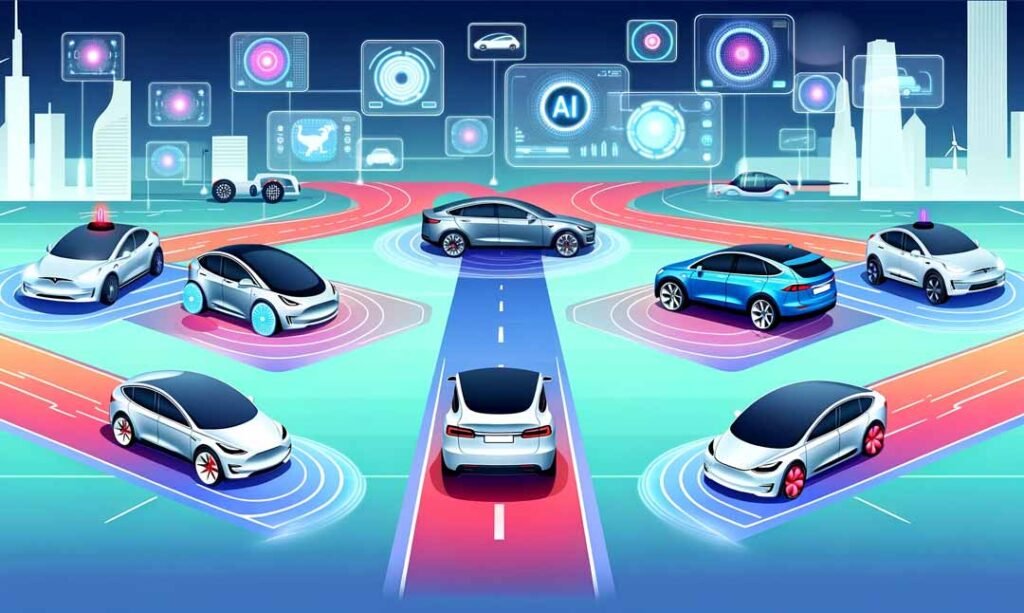
Several companies are leading the way in AI and self-driving car technology, showing the potential and impact of these innovations.
1. Tesla
Tesla is famous for its advanced driver-assistance systems and self-driving capabilities. The company’s AI-powered Autopilot system provides features like adaptive cruise control, lane-keeping assistance, and automatic emergency braking. Tesla continues to innovate and push the boundaries of autonomous vehicle technology.
2. Waymo
Waymo, a subsidiary of Alphabet Inc., pioneered autonomous driving technology. Waymo’s self-driving cars have logged millions of miles on public roads, demonstrating the feasibility and safety of autonomous driving. The company is focused on developing fully autonomous ride-hailing services.
3. NVIDIA
NVIDIA provides AI computing platforms for the automotive industry. Its DRIVE platform integrates AI functionalities like perception, mapping, and path planning, allowing self-driving cars to navigate complex environments. NVIDIA collaborates with several automotive plants to advance autonomous vehicle technology.
4. BMW
BMW is integrating AI into various aspects of its vehicles, including driver assistance systems and in-car infotainment. The BMW Intelligent Personal Assistant uses natural language processing to interact with drivers, providing a personalized and convenient driving experience. BMW’s commitment to AI reflects its vision for the future of mobility.
5. Uber
Uber is heavily invested in autonomous vehicle research and development. The company aims to deploy self-driving cars for its ride-sharing services, offering safer and more efficient transportation options. Uber’s autonomous vehicle program focuses on AI-driven decision-making and real-time navigation.
Concluding Thoughts
AI in self-driving cars is transforming the automobile industry, leading to major safety, efficiency, and convenience improvements. Although there are challenges ahead, the potential benefits and ongoing advancements in technology suggest a bright future for autonomous vehicles.
As AI technology continues to grow, self-driving cars are expected to become an integral part of our transportation. They promise to make travel safer and more efficient, opening up new possibilities for accessible mobility.


Why Did Apple Pull Advanced Data Protection in the UK: What’s Actually Going On?

Study Smarter: How Next-Generation Online Education Delivers Real-World Results

Top 5 Market Research Firms in the UK

The Impact of AI on Modern Financial Decision-Making

How Students Can Stay Connected During Study Abroad and Gap Year Adventures

Bridging the Gap Between Innovation and Real-World Project Delivery

Silent Engines of Industry: The Lifeblood Behind Every Machine

Upgrade Your Bedroom with Custom Wardrobes Made for You

A Winter Market Snapshot: Sittingbourne Buyer Demand and Pricing Trends

Graffitifun graffiti workshops: creative teambuilding and outings redefined

Carol Kirkwood’s Journey: Her Real Age, Husband, Career, and More

Revolutionizing Healthcare: The Emergence of AI-Driven Analytics

How Machine Learning and AI are Redefining the Future?

Aliza Barber: Meet Lance Barber’s Wife, Age, Life, Profile, Career and Net Worth

Evelyn Melendez: Jordan Knight’s Wife Bio, Marriage, Family, Career and Net Worth

Ilan Tobianah Biography: Family, Marriage, Lifestyle, Career and Net Worth

Who was Alice Marrow? Everything to Know About Ice-T’s and His Mother

King Von’s Autopsy Report: The Truth Behind the Tragic Death

Meet Otelia Cox: The Supportive Wife of Tony Cox – A True Fairy Tale Romance

Tea Leoni and Tim Daly Split – A Closer Look at Their Relationship and Breakup

Why Did Apple Pull Advanced Data Protection in the UK: What’s Actually Going On?

Study Smarter: How Next-Generation Online Education Delivers Real-World Results

Top 5 Market Research Firms in the UK

The Impact of AI on Modern Financial Decision-Making

How Students Can Stay Connected During Study Abroad and Gap Year Adventures

Bridging the Gap Between Innovation and Real-World Project Delivery

Silent Engines of Industry: The Lifeblood Behind Every Machine

Upgrade Your Bedroom with Custom Wardrobes Made for You

A Winter Market Snapshot: Sittingbourne Buyer Demand and Pricing Trends

Graffitifun graffiti workshops: creative teambuilding and outings redefined
Category
Trending
-

 News3 months ago
News3 months agoCarol Kirkwood’s Journey: Her Real Age, Husband, Career, and More
-

 Health2 years ago
Health2 years agoRevolutionizing Healthcare: The Emergence of AI-Driven Analytics
-

 Technology2 years ago
Technology2 years agoHow Machine Learning and AI are Redefining the Future?
-

 Celebrity2 years ago
Celebrity2 years agoAliza Barber: Meet Lance Barber’s Wife, Age, Life, Profile, Career and Net Worth






